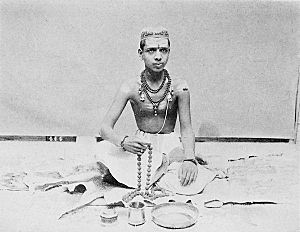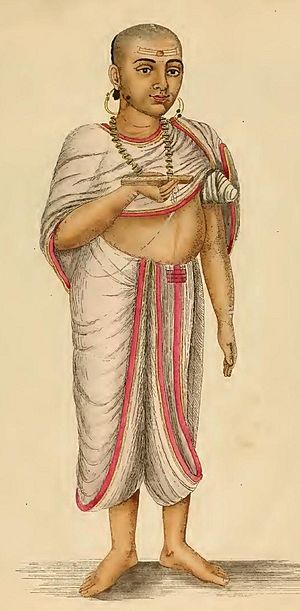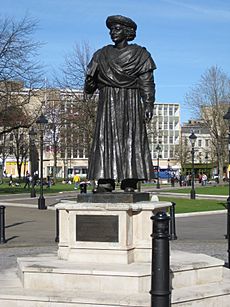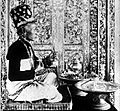Brahmin facts for kids
Brahmin is a part of the caste system in Hinduism. Brahmins are the highest and most respected caste of people. In ancient India Brahmins were people who read the complete Upanishad Brahmanak. They were teachers, warriors, doctors, scholars, or religious people in the past. They are called Dwij because they guided others toward enlightenment.
Both Buddhist and Brahmanical literature define "Brahmin" not in terms of family of birth, but in terms of personal qualities. Brahmin was someone who was good and virtuous, not just someone of priestly class.
There are many subgroups in Brahmins based on demography. Rishiswar, Sanadhya, Kanyakubj, Telang, Saryupareen, Bhumihar, Goswami, Tyagi, and Saraswati are the main streams of Brahmin.
Caste system
The caste system classified people by jobs. The people in this caste were the most prestigious and elite non-Buddhist figures. They were mostly priests and teachers. However, some sources mention Brahmins as being farmers, handicraft workers and artisans such as carpentry and architecture.
Historical records from mid 1st millennium CE and later, suggest Brahmins were agriculturalists and warriors in medieval India. Brahmins are sometimes mentioned as merchants who "carried on trade in horses, elephants and pearls" and transported goods throughout medieval India before the 14th-century.
Duties
Ancient Indian texts describe the duties and role of Brahmins. According to them, Brahmins were men of wisdom and virtues. They were expected to perform all six Vedic duties as opposed to other twice-borns who performed three. The Brahmins performed rituals such as solemnising a wedding with hymns and prayers. Most Brahmins practiced vegetarianism.
| Adhyayan (Study Vedas) |
Yajana (performing sacrifice for one's own benefit) |
Dana Giving Gifts |
Adyapana Teaching Vedas |
Yaajana Acting as Priest for sacrifice |
Pratigraha (accepting gifts) | |
|---|---|---|---|---|---|---|
| Brahmin | ✓ | ✓ | ✓ | ✓ | ✓ | ✓ |
| Kshatriya | ✓ | ✓ | ✓ | No | No | No |
| Vaishya | ✓ | ✓ | ✓ | No | No | No |
History
Brahmins weren't mentioned in any Indian texts between third century BCE and the late first century CE. This doesn't mean that Brahmanical culture did not exist at that time. It is likely that it was confined to rural folk and, as a result, went unrecorded.
Brahmins' role as priests and repository of sacred knowledge, as well as their importance in the practice of Vedic rituals, grew during the Gupta Empire.
Prominent Brahmins
Chanakya, a Brahmin born in 375 BCE, was an ancient Indian polymath who was active as a teacher, author, strategist, philosopher, economist, jurist, royal advisor, who assisted the first Mauryan emperor Chandragupta Maurya in his rise to power and is widely credited for having played an important role in the establishment of the Maurya Empire.
Many of the prominent thinkers and earliest champions of the Bhakti movement were Brahmins. Among them were Ramanuja, Nimbarka, Vallabha and Madhvacharya of Vaishnavism, Ramananda, another devotional poet sant.
Born in a Brahmin family, Ramananda welcomed everyone to spiritual pursuits without discriminating anyone by gender, class, caste or religion (such as Muslims). He composed his spiritual message in poems, using widely spoken vernacular language rather than Sanskrit, to make it widely accessible. The Hindu tradition recognises him as the founder of the Hindu Ramanandi Sampradaya, the largest monastic renunciant community in Asia in modern times.
Other medieval era Brahmins included Andal (9th-century female poet), Basava (12th-century Lingayatism), Dnyaneshwar (13th-century Bhakti poet), Vallabha Acharya (16th-century Vaishnava poet), Chaitanya Mahaprabhu(14th-century Vaishnava saint) were among others.
Images for kids
-
Adi Shankara a proponent of Advaita Vedanta, was born in a Brahmin family, and is credited with unifying and establishing the main currents of thought in Hinduism.
-
Among the Hindus of Bali, Indonesia, Brahmins are called Pedandas. The role of Brahmin priests, called Sulinggih, has been open to both genders since medieval times. A Hindu Brahmin priestess is shown above.
See also
 In Spanish: Brahmán (casta) para niños
In Spanish: Brahmán (casta) para niños









